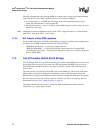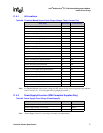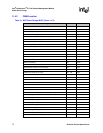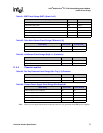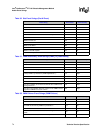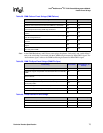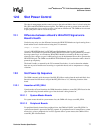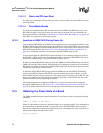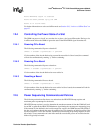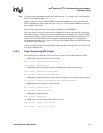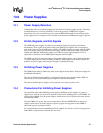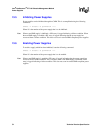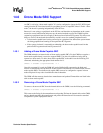
Intel
®
NetStructure
TM
ZT 7102 Chassis Management Module
Slot Power Control
78 Technical Product Specification
12.2.1.3 Fabric and PCI-Less Slots
For node slots containing no PCI bus (PCI-less slots) as well as fabric slots, the CMM will always
assert BD_SEL#.
12.2.1.4 Drone Mode Boards
For drone mode capable boards that have been added to the CMM, the CMM will always assert
BD_SEL# regardless of the type of node slot where they are inserted. For more information on
drone mode and drone mode boards, see Section 14.0, “Drone Mode SBC Support” on page 85. All
Intel SBCs are recognized as drone mode capable.
12.2.2 Assertion of HEALTHY# During Power-Up
Upon assertion of BD_SEL#, the CMM will wait a minimum of two seconds for the board to assert
the HEALTHY# signal. The amount of time the CMM will wait for HEALTHY# to be asserted by
an SBC can be configured from the CMM interfaces from 2 to 60 seconds and is referred to as the
HEALTHY# ramp up time. See Section 12.5, “Power Sequencing Commands and Policies” on
page 79 for instructions on how to set and retrieve the HEALTHY# ramp-up time.
A board should generate a HEALTHY# signal indicating all of its onboard voltages are good per
the PICMG 2.1 R2.0 specification. Depending on the logic of the board, HEALTHY# can also be
generated by additional logic, such as from a BIST, OS boot-up, etc.
If within the defined HEALTHY# ramp-up time the CMM detects HEALTHY# being asserted, the
CMM will leave BD_SEL# asserted, and the board will go through its normal power-on sequence.
BD_SEL# will remain asserted unless the HEALTHY# signal gets deasserted for that board or the
command to power down a board is issued.
If within the defined HEALTHY# ramp-up time the CMM does not detect HEALTHY# being
asserted, the CMM will deassert BD_SEL# to that slot, and that board will not power up. If the
board remains inserted in the slot, the process will repeat on the next polling cycle of that slot. This
process will continue until either the board powers up, the board is removed from the slot, or the
maximum number of power up attempts is reached.
The maximum number of attempts the CMM will try to power on a board can be configured
through the CMM interfaces. See Section 12.5, “Power Sequencing Commands and Policies” on
page 79 for further information on how to set and retrieve the maximum power-up attempts.
12.3 Obtaining the Power State of a Board
The CMM can obtain the power state information of a board at any time by issuing the following
command:
cmmget -l bladeN -d powerstate
Where N is the number of the slot in which the blade you are querying resides. This command will
give information on whether the blade is present, the state of the HEALTHY# signal (asserted/
deasserted), whether the board has been powered up or not, and whether the slot is in the active or
offline mode. Output will look similar to this:
Board is present



